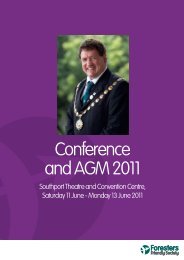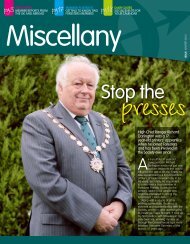Download this issue - Foresters Friendly Society
Download this issue - Foresters Friendly Society
Download this issue - Foresters Friendly Society
You also want an ePaper? Increase the reach of your titles
YUMPU automatically turns print PDFs into web optimized ePapers that Google loves.
20 Seaside traditionsBeside theseasideAs British as f ish and chipsDid you know, there are more than 10,000fish and chip shops in the UK and thatannually, 229 million portions of fried fish and277 million portions of chips are sold?It’s thought that the first fish and chip shopwas opened in London by Joseph Malinaround 1860. Outlets soon sprung up acrossthe country and became as much a part ofVictorian England as steam trains and smog. Tokeep prices down, portions were often wrappedin old newspaper – a practice that survived aslate as the 1980s, when it was ruled unsafe forfood to come into contact with newspaper inkwithout greaseproof paper in between.The good news is that, as well as beinga long-held seaside tradition, fish and chipsmake a balanced and nutritious meal and area valuable source of protein, fibre, iron andvitamins.To find great fish and chip shopsnear you, type your postcode into the searchengine at www.qualityfishandchips.co.uk/find-a-chip-shop. Enjoy!Sources: www.chips.lovepotatoes.co.uk, www.independent.co.ukand www.federationoffishfriers.co.ukOh we do love it!And here arejust a fewreasons why...Britain’s seaside resorts as we know andlove them really took off in the late 19thcentury. Thanks to the expansion of therail network, it suddenly became possible for‘ordinary folk’ to visit coastal destinations fromBlackpool to Brighton. These days, when wethink of seaside holidays, it’s with a heartfeltfondness for the quintessential newspaperwrappedfish and chips, blustery pier andchirpy entertainment. But what are the originsof the seaside traditions we hold so dear?A brief history of Mr Punch“Aghh,” screams the policeman, as Punchrepeatedly thwacks him. “It’s behind you!”shouts the audience at the top of their lungs.Mr Punch descends from Italian clownPulcinella, who featured in the Commediadell’Arte (Italian comedy) medieval tradition ofthe 16th century.Diarist SamuelPepys recallsseeing Punch inLondon’s CoventGarden in 1662:“Thence to see anItalian puppet playthat is within therayles there, whichis very pretty, thebest that ever Isaw, and greatresort of gallants.”Westonsuper-Maremade seasidedonkey rides famousin the 1880s. The Magerfamily have been givingchildren rides on donkeysalong Weston for morethan 100 years.So successful was <strong>this</strong> inaugural show,that by the early 1800s Punch was beingperformed regularly in all the major citiesacross Britain. Every show included a dry,satirical look at politics, similar to the late1980s TV show Spitting Image. Theaudience empa<strong>this</strong>ed with quick-temperedPunch, laughing raucously at his constantquandaries and angry wife. The show’spolitical theme even helped to inspire thename of the popular satirical magazine,Punch (1841-2002), which published workby WM Thackeray, PG Wodehouse andSir John Betjeman.With train travel’s advancements andthe introduction of Bank Holidays in1871, seaside trips became accessible tothe everyday family – which is when thecrocodile first appeared in performances.With <strong>this</strong>, together with social andcultural developments, the key audienceshifted to giggling children – somethingthat remains to <strong>this</strong> day.Mine’s a 99The mention of one number instantly conjuresup sepia-drenched images of the Great Britishsummer. A soft, cream-coloured swirled massatop a beige, wafer torch base, sporting aflaky finger of chocolate – the iconic 99.Cadbury’s website states that the origin ofour beloved ‘99’ name, is “lost in the mistsof time”. However, there are several claims toits provenance, one of which comes from theArcari family from Portobello, Scotland. Thestory goes that Rudi Arcari’s father, Stephen,would break a large Flake in half and stickit in an ice cream. A sparky Cadbury’s reptook <strong>this</strong> idea back to the company andthe Flake 99 was born – named 99 simplybecause the Arcari’s shop was located at 99Portobello High Street.British holidaymakers have since enjoyedcopious 99s, regardless of the weather– devouring a 99 in gale force wind hasbecome a true symbol of our resilient Britishholiday spirit! And, as no one knows thedefinitive origin of <strong>this</strong> delicious sweet treat,if you can shed some light, do let us know!Pier into the pastPiers were built for a variety of functions –from working piers handling passengers andcargo, to fishing piers and the vibrant, spinningtechnicolour pleasure piers. The first recordedpier in England was Ryde Pier, opened in 1814on the Isle of Wight as a landing stage to allowferries to and from the mainland to berth. It’sstill used for <strong>this</strong> purpose today (see below).At the turn of the last century, almosta hundred pleasure piers existed acrossEngland and Wales, becoming an essentialMany of our piers have experiencedrefurbishments of late and have beenrestored to their former glory...Winner of Pier of the Year 2013,elegant Clevedon Pier is the only fullyintact Grade 1-listed pier in Britain.Southend Pier is the longest pier inthe world, at 1.3 miles. It has survivedtwo world wars and several fires.Blackpool has three piers, eachpacked with arcades, bars, rides andviews across the Irish Sea.landmark of fashionable Victorian seasideresorts. These were initially built for visitorsto be able to promenade over and alongsidethe sea at all times, whether or not the tidewas out.As seaside holidays became an ever-moreaccessible option, Britain’s coastal resortsand piers morphed into a paradise of games,fairgrounds and fun. But times continued tochange and the rise of foreign holidays resultedin a decline for many UK coastal towns andtheir attractions. Today, the National Piers<strong>Society</strong> estimates that just 55 piers survive.Clevedon Pier, Winnerof Pier of the Year 2013Construction of the Palace Pier atBrighton began in 1891. It oncehad an ‘end of the pier’ concert hallfeaturing summer shows by the likesof Tommy Trinder. This has long sincebeen replaced by an amusementarcade and fairground rides.Ryde Pier on the Isle of Wight still fulfilsits purpose of allowing ferry passengersto disembark and continue their journeyvia train. The line continues to beserved by 1930s London Undergroundtrains, making for a perfectly nostalgic,step-back-in-time experience.Life’s a beachWe’re incredibly lucky to have a multitude ofspectacular beaches in Britain. Here are just afew of our favourites...Watergate Bay, Cornwall: This stunningseaside spot is a favourite with surfers,kayakers and climbers.Watergate Bay,CornwallHuisinis, Isle of Harris: At theend of a 15-mile, single track road on themountainous north coast lies a glistening,unspoilt gem of a beach.Barafundle Bay, Pembrokeshire: Abeautiful hidden bay, protected by its cliffsurrounds and east-facing location.Barafundle Bay,PembrokeshireStone Bay, Broadstairs, Kent: Huggedby chalky cliffs, <strong>this</strong> peaceful bay hasgreat rockpooling potential for kids.West Kirby, Wirral, Merseyside: Just300 metres long, <strong>this</strong> sandy beach withits sparkling waters benefits from thebeautiful Welsh coastline as a backdrop.Images: Loop Images, Alamy, Getty
















